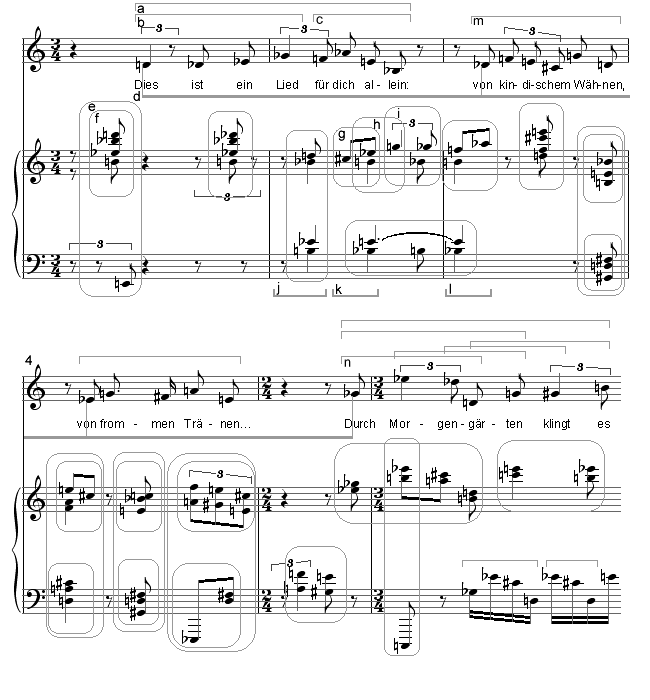|
|
|||
| 3. Analysis and segmentation |
"Analysis" means "taking apart." Nearly all pieces of music provide such complex experiences that, if we are to study them, we must dissect them. One immediate strategy in this regard is to focus our attention separately on the elements that make up music. In pc set analysis, for instance, we investigate music’s pitch organization, leaving as secondary issues of rhythm, texture, timbre, and the other elements with which pitches are bound up in our musical experience.
Another necessary strategy is segmentation: we partition the music into analyzable fragments. Two familiar types of fragments are chords, units whose pitches sound together; and motives, units whose pitch, contour, and/or rhythmic designs are used repeatedly. In pc set analysis, the principal unit is the pitch-class set. A pc set is a (usually) unordered collection of (usually) between three and nine pitch classes. (The term "set" is a mathematical one. It betrays the fact that the axioms and operations of this analysis can be viewed as -- mostly rudimentary -- applications of mathematical set theory.)
Pc sets can be abstracted from the pitches in melodic, in harmonic, and in mixed musical segments. Deciding upon these segments -- segmentation -- is the first step when when we analyze a piece of music. Analysts usually base their decisions on "common-sense" contextual clues gained from careful score reading and listening. Sometimes, however, the intricacies of atonal music can make segmentation difficult. It is a process in which the skill, experience, and aims of the analyst all influence decisions.
In Example 3-1 the first six measures of Webern’s op 3., no. 1 song
have been given sample segmentations.
Example 3-1. Webern, song op. 3, no. 1, mm. 1-6

This example illustrates several common segmentation strategies, and it suggests a few ways of indicating segments.
- Each instrument's material, considered separately. Here melodic segments
in the voice are indicated by brackets. Segments in the piano’s
more harmonic material are mostly enclosed by boxes. Naturally, segments
can also encompass more than one instrument; the thick brackets of segments
j, k, and l, for instance, are meant to embrace
material above them for both piano and voice. (In many other places
here the voice adds nothing new to the piano's pitch class material.)
- The work’s motivic gestures. This song happens to feature much
varied imitation of short melodic gestures, and all appearances of these
gestures might be considered segments. The material in vocal segments
b, c, m, and n, for instance, recurs in
several other segments.
- Gestures bounded by rests or grouped by beams or slurs. These criteria
suggest segmenting the four overall phrases of the vocal part as well
as several gestures in the piano’s material.
- In vocal music, gestures spanning textual units. Here the first two
lines of text ("Dies ist ein Lied / für dich allein")
suggest breaking segment a into segments b and c.
- Vertical sonorities – chords – with or without adjacent
"non-harmonic" pitches. In common-practice harmonic analysis,
there are secure criteria for omitting non-harmonic tones from harmonic
segments. The analyst may or may not wish to apply -- and defend! --
these or similar criteria in pc set analysis.
- Inclusive segments. In measure 4, for instance, the separate segments
formed by materials in the piano’s two staves are also combined
into larger segments; and in measure 1, segment e adds a bass
note to segment f.
- Overlapping segments. In measure 2, segments g, h and
i overlap in the piano part. In measures 5-6, the final vocal
phrase has been subjected to a similar technique, called imbrication.
Its first four notes suggest themselves as a segment, n, since
they present a retrograde version of the pcs in segment b. The
remainder of this phrase, however, is then systematically parsed in
overalapping groups of four notes: 2-5, 3-6, and 4-7.
- Non-contiguous segments. Nearly all the segments presented here feature adjacent notes, notes that we might expect to be related to each other somehow. Grouping non-adjacent pitches into segments is a less secure enterprise, and the analyst should have some defensible criterion for relating pitches distant from each other. One possibility is exemplified by segment d, which comprises the opening notes of the four vocal phrases; the notes are stemmed and linked by a beam. The discovery that these notes mirror the pitches of segment b, suggests their status as a viable segment.
The segmentations presented above are certainly not exhaustive, and it's likely that not all of them will yield analytically useful results. They illustrate, however, that you should be both open to trying alternatives in your segmentation and able to defend the choices you make. One ideal for segmentation is that -- since you will be looking for pitch-class content in these segments -- the criteria for segmentation should be non-pitch based. In practice, however, the analyst usually tempers this ideal as patterns and relationships among pc sets emerge during the analysis.
|
Key concepts on this page:
|
| Page last modified 20 July 2001 / GRT |
|
|||